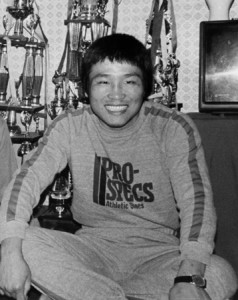The tragic title fight that changed boxing

This undate picture shows South Korea’s late boxer Kim Duk-Koo at his home in Seoul before his departure for Las Vegas for a bout with world lightweight champion, Ray “Boom Boom” Mancini in 1982. Kim died after being knocked down in the title bout. AFP / DONG-A ILBO
SEOUL — Thirty years ago this month, South Korean boxer Kim Duk-Koo entered a Las Vegas ring for a world championship bout that would end with his death, trigger at least one suicide and change the sport forever.
For a generation of South Koreans, millions of whom watched live on television, the fight between Kim and world lightweight champion, Ray “Boom Boom” Mancini, remains a powerful memory.
Now a new book and accompanying documentary that coincide with the 30th anniversary hope to shed fresh light on the bout, its tragic aftermath and the impact it had on the lives and families of its two protagonists.
For Kim, then 23 and fighting for the first time in the United States, the glitz of Caesar’s Palace with its celebrity audience including the likes of Frank Sinatra, was a different universe from his impoverished upbringing in Korea.
“I remember when we landed in Las Vegas for the fight,” his trainer, Kim Yoon-Gu, now 56, recalled.
“The city was all lit up at night. It was like landing on a garden of flowers in the desert. We’d never seen anything like it,” he told Agence France-Presse at the boxing gym he runs in Seoul.
US boxing commentators had pretty much written Kim Duk-Koo off before the November 13, 1982 clash with Mancini, a powerful 21-year-old from Youngstown, Ohio making his second defence of the world title.
But Kim was confident. Before leaving Seoul he had a carpenter rig up a mock coffin which he said he would use to bring back Mancini after the fight.
Unimpressed with such bravado, his trainer stomped it to pieces which he then hid under the ring in Kim’s training camp.
A brutal fight
The fight when it came was a particularly brutal one.
For 13 rounds, the two men went toe-to-toe in a slugging match that left both with badly swollen faces and struggling to see through bruised, puffed-up eyes.
At the end of the 13th, Kim Yoon-Gu tried to lift his fighter, telling him Mancini was exhausted and exhorting him to put in one last effort to finish him off.
“He clenched his teeth, nodded and said ‘Yes, I’ll do that’. And that was it. That was the last thing he ever said,” Kim said.
At the beginning of the 14th, Mancini connected with a straight right that snapped Kim’s head back and sent him crashing to the canvas.
The Korean managed to haul himself up by the ropes to beat the count, but referee Richard Green stepped in to stop the fight.
Kim Yoon-Gu had been tending to his corner and missed the actual knockout blow, but when he saw Kim on the ground, he knew at once that the fight was over.
“He was obviously hurt, but at that time we had no idea it was so serious,” he said.
Back in his corner, Kim collapsed and was taken from the ring on a stretcher to hospital where he was diagnosed with a blood clot on the brain and underwent emergency surgery.
He lapsed into a coma from which he never recovered and four days later he died.
On the flight back to South Korea, a traumatised Kim Yoon-Gu locked himself in the toilet and “cried and cried until we landed.
“I thought about quitting the sport entirely. In the end, I decided to stick with it, but it was a very, very difficult time,” he said at his gym where photos and posters of Kim Duk-Koo adorn the walls.
Suicide, depression and redemption
The consequences of the Kim-Mancini bout were far-reaching and tragic in their own right.
Four months after her son’s death, Kim’s distraught mother killed herself by drinking a bottle of pesticide.
Four months after that, referee Richard Green also took his own life, although there was no indication that his suicide was linked to the outcome of the fight for which he was never held in any way responsible.
Mancini, a devout Catholic, endured a prolonged period of depression and, although he fought again, was never the same boxer.
“In all the obvious ways, he was haunted,” American sportswriter Mark Kriegel, author of a new biography of Mancini titled “The Good Son,” told AFP in a telephone interview.
“He also got over it. The complications for Ray have more to do with the fact that the rest of the world didn’t get over it and continued using that fight as a kind of reference point for his life,” Kriegel said.
Kriegel’s book, and an accompanying documentary of the same name, climax with an emotional reunion in June last year between Mancini and Kim’s family.
Kim’s fiancee, Lee Young-Mee, had been pregnant at the time of the 1982 title fight and seven months later gave birth to a son, Kim Jiwan, now 29.
While being interviewed by Kriegel for the book, Jiwan had suggested a trip to the United States to meet with Mancini.
“As full of duty and obligation as Ray was, he wasn’t going to turn down a request from the son of the man who, without intention, died at his hands,” Kriegel said.
At the meeting in Mancini’s home, Jiwan admitted to the “hatred” he once felt for the boxer, before absolving him of any blame.
“I think it was not your fault,” he said.
The Kim-Mancini bout proved to be a watershed in boxing, triggering a series of major changes to the sport.
Championship bouts were reduced from 15 to 12 rounds, the standing eight-count was introduced and the medical tests required of boxers before a fight were overhauled.